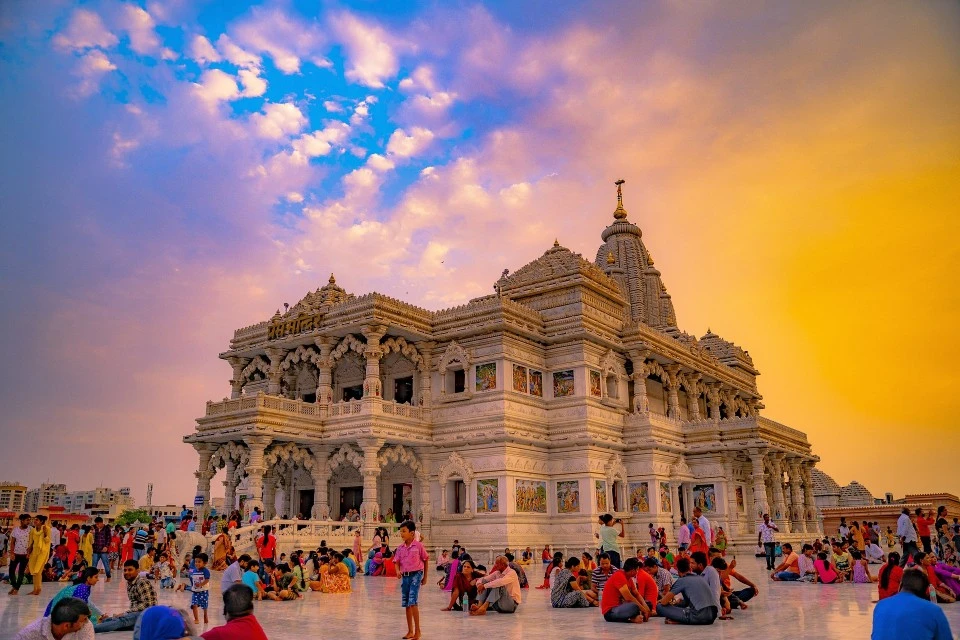Hi, How can I help you ?
Hi, How can I help you ?

Vrindavan, located in the Mathura district of Uttar Pradesh, is one of the most revered pilgrimage sites in India. Known for its spiritual significance, rich cultural heritage, and connection to Lord Krishna, it attracts millions of devotees and tourists alike. A visit to Vrindavan promises an immersive experience of temples, ghats, and the serene beauty that has inspired centuries of devotion and artistry. In this guide, we will take you through the key spiritual treasures and temples in Vrindavan, ensuring that your trip is filled with enriching experiences.
Our Vrindavan Tour Package
View All 
1. The Birthplace of Lord Krishna
Vrindavan holds immense significance in Hindu mythology, particularly in connection with Lord Krishna, who is believed to have spent his childhood here. The town is infused with the essence of Krishna's divine presence, and its landscape is dotted with temples dedicated to various aspects of his life. Every corner of Vrindavan tells a story, making it a must-visit for spiritual seekers.
2. Temples of Vrindavan: The Heart of the Town
Vrindavan is home to over 5,000 temples, each with a unique history and significance. Some of the most famous temples you should not miss are:
Banke Bihari Temple: One of the most iconic temples in Vrindavan, the Banke Bihari Temple is dedicated to Lord Krishna. The temple’s architecture, along with its captivating idol of Krishna, draws pilgrims from all over the world. The temple is known for its vibrant atmosphere, especially during festivals like Holi and Janmashtami.
ISKCON Vrindavan: The International Society for Krishna Consciousness (ISKCON) has a prominent temple in Vrindavan. This temple offers spiritual teachings, prayers, and a peaceful ambiance. It's perfect for devotees seeking a blend of tradition and modernity.
Radha Raman Temple: This temple is dedicated to Lord Krishna and Radha, symbolizing the divine love between them. The temple houses an ancient deity of Radha Raman, a beautiful representation of Lord Krishna.
Prem Mandir: A relatively newer addition to Vrindavan’s spiritual landmarks, Prem Mandir stands as a symbol of love and devotion. The temple's exquisite marble structure and colorful lights add a modern touch to the traditional religious setting.
Goverdhan Hill and Temple: Located on the outskirts of Vrindavan, the Goverdhan Temple is dedicated to Lord Krishna’s iconic act of lifting the mountain to protect his devotees. Pilgrims often circumambulate the hill, known as ‘Parikrama,’ as part of their devotional practices.
3. Holy Ghats of Vrindavan
The ghats of Vrindavan hold a special place in the hearts of devotees. These steps leading to the Yamuna River are where Krishna is said to have performed many of his divine pastimes. A visit to these ghats is an essential part of the Vrindavan experience. Some of the notable ghats include:
Keshi Ghat: One of the largest and most important ghats in Vrindavan, Keshi Ghat is named after the demon Keshi, who was slain by Krishna. It is believed that Krishna bathed in the Yamuna here.
Yamuna Ghat: The Yamuna River is sacred, and taking a boat ride on its serene waters while watching the evening aarti is a must-do for anyone visiting Vrindavan.
Radha Ghat: Dedicated to Radha, Krishna’s beloved consort, this ghat is the perfect place for meditation, prayer, and reflection on the divine love between the two.
4. Festivals and Celebrations
Vrindavan is famous for its vibrant festivals, with Janmashtami (the birthday of Lord Krishna) being the most significant. During this time, the temples are beautifully decorated, and the streets come alive with processions, music, and dance. Holi, the festival of colors, is also celebrated here in a grand and unique way, reflecting the playful spirit of Krishna’s pranks with his devotees.
5. Vrindavan's Spiritual Atmosphere
One of the most powerful aspects of Vrindavan is its spiritual atmosphere. The entire town is imbued with divine energy, with every temple, ghat, and tree telling a story of Krishna’s life and teachings. The silence in the early mornings, the ringing of temple bells, the chanting of mantras, and the sound of the Yamuna River flowing nearby all contribute to the feeling of being in a holy sanctuary.
6. The Secret Gardens and Trees of Vrindavan
Vrindavan is also known for its sacred groves and gardens that have been a part of Krishna's pastimes. The Nidhivan and Seva Kunj are two such spots that have special significance. Nidhivan is believed to be the place where Krishna and Radha performed their divine dances (Raas Leela). Devotees believe that the spirits of Krishna and Radha still dance here at night.
7. Local Cuisine and Spiritual Shopping
While the primary focus of a Vrindavan tour is spiritual, the town also offers a taste of local delicacies. From makhan mishri (a sweet made of butter and sugar) to kachaudi and peda, the local snacks are bound to leave you craving more. As you explore the streets, you’ll also find spiritual souvenirs like idols, paintings, and jewelry that make for perfect gifts and memories.
8. Best Time to Visit Vrindavan
The best time to visit Vrindavan is between October and March when the weather is pleasant and conducive for sightseeing and temple visits. The summer months can be quite hot, so it’s advisable to avoid traveling during this period.
Conclusion
A trip to Vrindavan is not just about sightseeing; it’s an opportunity to connect with the divine, immerse yourself in spiritual practices, and experience the culture and devotion of India. The town is a treasure trove of history, spirituality, and beauty, offering something for every type of traveler—whether you're seeking peace, devotion, or the joy of witnessing a rich cultural legacy.
If you’re looking to explore Vrindavan, consider opting for Vrindavan tour packages that will allow you to visit the most iconic temples, ghats, and sacred places while making the most of your time in this holy town.